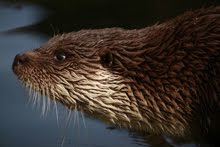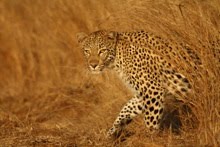On Saturday morning I popped out to my local patch (the Inzinger Gaisau, western Tirol) for a bit of birding. The sheer number and diversity of birds singing was staggering and completely overwhelming after the long, slow birding winter.
Everywhere I looked, the Fieldfares (Wacholderdrossel) were chirping and whizzing about collecting nesting material and fat, juicy worms. The blackcaps (Mönchsgrasmücke) were singing all over the place, and there were even a few willow warblers chirping (Fitis).
 There are 7 ridiculously cute Tufted Ducks about at the moment. Last year one pair bred, successfully raising 3 offspring.
There are 7 ridiculously cute Tufted Ducks about at the moment. Last year one pair bred, successfully raising 3 offspring.
Getting on to the main pond, I picked up a moorhen playing bold - a rather shy (uncommonly seen) breeding bird here. Scanning the pond with my scope I was astonished to see a pair of Goosander (Common Merganser, Gänsesäger) right out in the open on the pond - a patch tick for the Inzinger Gaisau!
I wonder why they are still about so late? (i.e. feel free to comment ;-)
The biggest sighting of the day was a single Green Sanpiper (Waldwasserläufer). I had heard one last year at migration time but did not manage to get a glimpse of it. In typical Green Sandpiper fashion, the bird was shy and stayed a long way away, but I managed to digiscope a couple of identification photos.
 The light speckling on the back and the olive-green legs suggest either a Green Sandpiper, Wood Sandpiper or Solitary Sandpiper (a rare vagrant from North America and congener of the Green Sandpiper).
The light speckling on the back and the olive-green legs suggest either a Green Sandpiper, Wood Sandpiper or Solitary Sandpiper (a rare vagrant from North America and congener of the Green Sandpiper).
 The dark bib has a distinct lower margin to it, unlike the Wood Sandpiper which has a more diffuse speckled bib that peters out between the breast and belly. The white eye stripe (supercilium) is clear in front of the eye and very faint behind the eye (unlike Wood Sandpiper), and the Green Sandpiper has much broader tail barring than the Wood Sandpiper.
The dark bib has a distinct lower margin to it, unlike the Wood Sandpiper which has a more diffuse speckled bib that peters out between the breast and belly. The white eye stripe (supercilium) is clear in front of the eye and very faint behind the eye (unlike Wood Sandpiper), and the Green Sandpiper has much broader tail barring than the Wood Sandpiper.

The dark underwings definitively separate the Green Sandpiper from the Wood Sadpiper, and the white rump patch excludes its very similar North American congener, the Solitary Sandpiper (what a find that would have been!).
Find other posts on the Gaisau here and a description of the site and how to get there here.
Happy birding
Dale Forbes
Everywhere I looked, the Fieldfares (Wacholderdrossel) were chirping and whizzing about collecting nesting material and fat, juicy worms. The blackcaps (Mönchsgrasmücke) were singing all over the place, and there were even a few willow warblers chirping (Fitis).
Getting on to the main pond, I picked up a moorhen playing bold - a rather shy (uncommonly seen) breeding bird here. Scanning the pond with my scope I was astonished to see a pair of Goosander (Common Merganser, Gänsesäger) right out in the open on the pond - a patch tick for the Inzinger Gaisau!
I wonder why they are still about so late? (i.e. feel free to comment ;-)
The biggest sighting of the day was a single Green Sanpiper (Waldwasserläufer). I had heard one last year at migration time but did not manage to get a glimpse of it. In typical Green Sandpiper fashion, the bird was shy and stayed a long way away, but I managed to digiscope a couple of identification photos.
The dark underwings definitively separate the Green Sandpiper from the Wood Sadpiper, and the white rump patch excludes its very similar North American congener, the Solitary Sandpiper (what a find that would have been!).
Find other posts on the Gaisau here and a description of the site and how to get there here.
Happy birding
Dale Forbes










.jpg)








.jpg)





5 comments:
Beautiful images, the 1st image of the Sandpiper is also very well composed
I like the first pic, pair Tufted Ducks.
The first Green Sandpiper knows how to posed for you on that dead trunk.
The black bulbul is 24 cm is size, not too big. Thanks for sharing your beautiful photos. For us, many of the migrating birds have left Taiwan already.
I like their tufty hair-do too.
I remember seeing solitary sandpipers before too here in the western u.s. Its fun that you have so much diversity in and near the mountains.
Hi all, thank you for your comments - it is wonderful to be able to share my love for all the cool things here with you all.
Thomas, the sandpiper was a long way away but I got lucky and managed to snap off two photos of it on the log before it flew off (the last photo on the blog). as for composing the photo in the field, I was more worried about trying to snap off "I saw it" shots than make anything pretty. but it little bit of input from the crop function made all the difference ;-)
Tabib, there is nothing uncool about Tufted Ducks. Fabulous!
Grace & Bradley, thank you for visiting my blog. Visiting Taiwan is way up on my list of things to do (my brother was just there and loved it). If I do, you will be sure to hear from me!
Bernie, when the little males are chasing each other around, they really get that fluffy mullet going!
the thing about the Alps (and mountain regions in general) is that there is diversity, but the density of individuals (at least the visible density) is very low, so you really have to work hard to find anything.
Nice Cormorant photos, btw!
Post a Comment